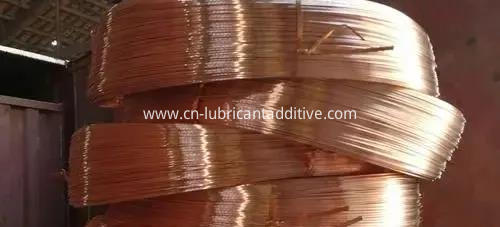
Privacy statement: Your privacy is very important to Us. Our company promises not to disclose your personal information to any external company with out your explicit permission.
News
Home > Industry News > How does copper wire drawing oil prevent oxidation and blackening?
2021-08-07
In the wire drawing process of my country's wire and cable industry, copper material and enameled wire industry, oxidation, discoloration and blackening are common, and it is more serious in spring and summer. With the popularization of existing high-speed machines, the drawing speed has been greatly improved, and the contradiction has become more and more prominent. For these problems and their relationships, I focus on the analysis of the temperature caused by the copper wire drawing process that affects oxidation lubrication and other issues: because the wire temperature and the friction between the wire and the mold directly affect the lubrication effect during the drawing process, the following Analyze the aspects: one is the fat content of the lubricating oil; the second is the stretching speed and the temperature of use; the third is the stretching force; the fourth is how to prevent oxidation and blackening.

The grease content of the drawing oil produced by almost every manufacturer is different. The grease content, viscosity and use temperature of the drawing oil are the main reasons that affect the lubricating effect. Let's analyze them separately:
There are many reasons for the blackening and oxidation of copper wires:
(1) The area of the wire drawing emulsified oil pool is small, the return pipe is short and sealed, which results in slow heat dissipation and high temperature of the emulsified oil.
(2) It is caused by copper wire annealing. Firstly, tap water and groundwater are generally used for cooling water for continuous cooling. Because the water quality varies from place to place, the PH value of water quality in some areas is low, only 5.5-5.0, and the anti-oxidant oil film in the original emulsion is washed away. , The annealed copper wire is easy to oxidize and turn black; the second is that the finished copper wire drawn on an ordinary wire drawing machine is annealed on another annealing line. The cooling water does not use antioxidants, and the antioxidant time is short, and it will appear soon Oxidation blackening phenomenon;
(3) Some old factories still use annealing cylinders for annealing, and the following reasons can also cause oxidation and blackening: one is that the annealing cylinder nut is not tightened, and the gas leaks after flushing carbon dioxide or high-purity nitrogen; second, the cylinder is discharged The temperature of the copper wire is too high, exceeding 30℃; third, the drawing emulsion is not maintained enough and the PH value is too low; these situations are more common when the temperature is high in summer, and the emulsion will be lost if the temperature is high. Faster, if the new crude oil is not replenished in time, the fat content is small at this time, and the temperature is high, the temperature of the emulsion may also exceed 45°C, which will easily cause oxidation and blackening.
Share to:
Send Inquiry

Mr. James
Tel:0086-371-58651986
Fax:
Mobile Phone:+86 13783582233
Email:sales@cn-lubricantadditive.com
Address:No.11 Changchun Road, High-Tech Zone, Zhengzhou, Henan
Related Products List
Mobile Site


Privacy statement: Your privacy is very important to Us. Our company promises not to disclose your personal information to any external company with out your explicit permission.

Fill in more information so that we can get in touch with you faster
Privacy statement: Your privacy is very important to Us. Our company promises not to disclose your personal information to any external company with out your explicit permission.